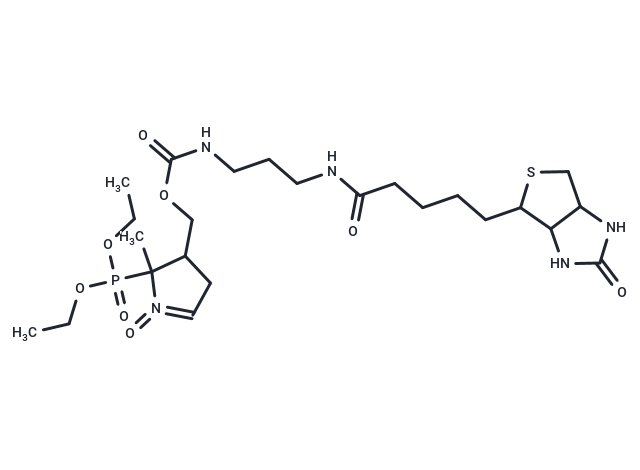 您的购物车当前为空
您的购物车当前为空
DEPMPO-biotin
一键复制产品信息DEPMPO is a nitrone that is used to spin trap reactive O-, N-, S-, and C-centered radicals and allow their characterization when used in association with electron spin resonance. It is noted for the stability of adducts formed. DEPMPO can be used in vitro or in vivo, as it crosses lipid bilayer membranes and is a good trapping agent in biological systems. DEPMPO-biotin is a biotinylated form of DEPMPO which retains the outstanding persistency of its adducts. The biotin moiety offers an effective means for monitoring biodistribution in cells, tissues, and organs when used with an avidin-conjugated reporter. Importantly, DEPMPO-biotin binds free radicals, such as S-nitroso groups, on proteins, producing adducts that can be analyzed via the biotin tag. This direct labeling of S-nitrosothiols (SNO) thus serves as an effective alternative to the more cumbersome biotin-switch method for monitoring SNO formation.

DEPMPO-biotin
一键复制产品信息DEPMPO is a nitrone that is used to spin trap reactive O-, N-, S-, and C-centered radicals and allow their characterization when used in association with electron spin resonance. It is noted for the stability of adducts formed. DEPMPO can be used in vitro or in vivo, as it crosses lipid bilayer membranes and is a good trapping agent in biological systems. DEPMPO-biotin is a biotinylated form of DEPMPO which retains the outstanding persistency of its adducts. The biotin moiety offers an effective means for monitoring biodistribution in cells, tissues, and organs when used with an avidin-conjugated reporter. Importantly, DEPMPO-biotin binds free radicals, such as S-nitroso groups, on proteins, producing adducts that can be analyzed via the biotin tag. This direct labeling of S-nitrosothiols (SNO) thus serves as an effective alternative to the more cumbersome biotin-switch method for monitoring SNO formation.
| 规格 | 价格 | 库存 | 数量 |
|---|---|---|---|
| 25 μg | ¥ 2,680 | 35日内发货 | |
| 50 μg | ¥ 4,930 | 35日内发货 | |
| 100 μg | ¥ 9,580 | 35日内发货 | |
| 250 μg | ¥ 20,800 | 35日内发货 |
DEPMPO-biotin 相关产品
产品介绍
| 产品描述 | DEPMPO is a nitrone that is used to spin trap reactive O-, N-, S-, and C-centered radicals and allow their characterization when used in association with electron spin resonance. It is noted for the stability of adducts formed. DEPMPO can be used in vitro or in vivo, as it crosses lipid bilayer membranes and is a good trapping agent in biological systems. DEPMPO-biotin is a biotinylated form of DEPMPO which retains the outstanding persistency of its adducts. The biotin moiety offers an effective means for monitoring biodistribution in cells, tissues, and organs when used with an avidin-conjugated reporter. Importantly, DEPMPO-biotin binds free radicals, such as S-nitroso groups, on proteins, producing adducts that can be analyzed via the biotin tag. This direct labeling of S-nitrosothiols (SNO) thus serves as an effective alternative to the more cumbersome biotin-switch method for monitoring SNO formation. |
| 分子量 | 591.66 |
| 分子式 | C24H42N5O8PS |
| CAS No. | 936224-52-1 |
| 存储 | Powder: -20°C for 3 years | In solvent: -80°C for 1 year | Shipping with blue ice/Shipping at ambient temperature. | |||||||||||||||||||||||||
| 溶解度信息 | Ethanol: 10 mg/mL (16.9 mM), Sonication is recommended. H2O: 1 mg/mL (1.69 mM), Sonication is recommended. | |||||||||||||||||||||||||
溶液配制表 | ||||||||||||||||||||||||||
H2O/Ethanol
Ethanol
| ||||||||||||||||||||||||||





 还可以
还可以

 |
|
评论内容